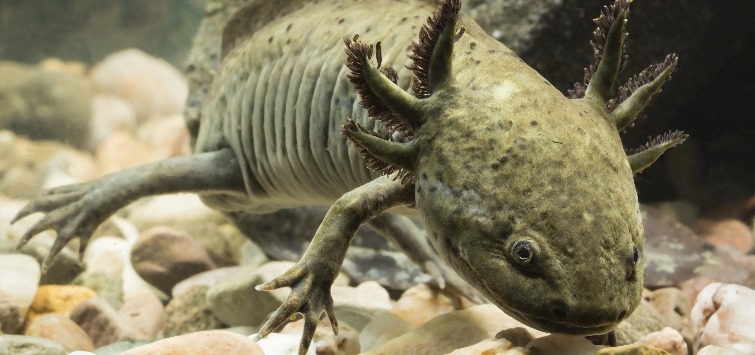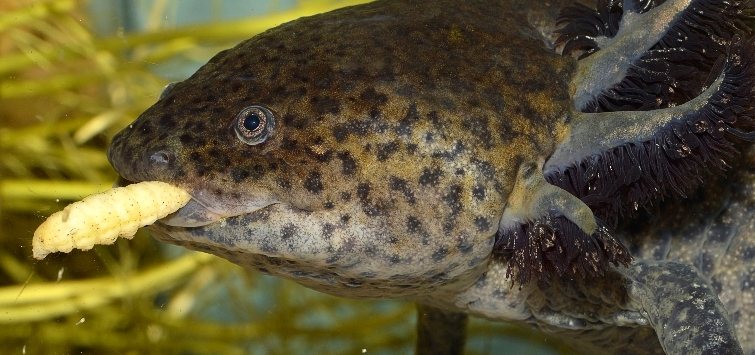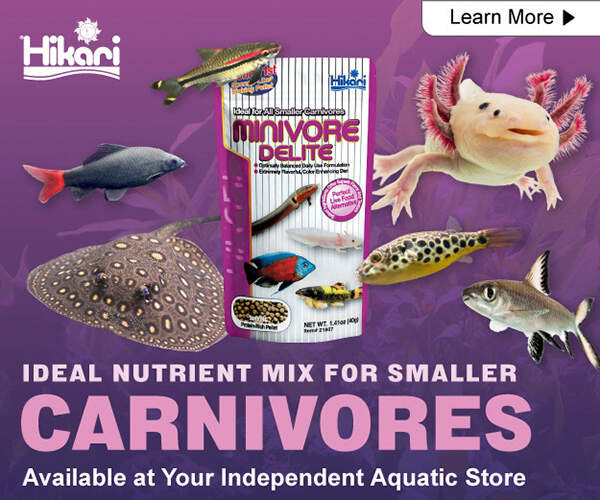Axolotl Care: Training, Feeding & More
Joshua Wiegert
I grew up in Schenectady, a small city in upstate New York. We were fortunate to have quite a few aquarium stores literally within walking distance of the house, something that just doesn’t exist anymore. One of the more unusual of these places was Rita and Eddie’s Aquarium. It was operated out of a converted house in a residential neighborhood. Rita and Eddie lived above the shop, along with their many cats. I remember browsing the many, many old tanks and watching the racks shake as people walked by.
Rita and Eddie’s tanks were always stocked with unusual fish, as well as other creatures. It was there that I first saw an axolotl. This weird creature looked like a cartoon version of a salamander, but with big, tufty gills. It had a big, flat head, a huge smile, and tiny, beady eyes. And it was downright adorable. I was told that, unlike the newts I had kept before or the salamanders I’d catch in the backyard, these beings were fully aquatic and would never leave the water. Sold!
After providing my axolotl care for some time, I was truly surprised when the gills began to vanish and my “axolotl” transformed into a beautiful, bright-yellow salamander with black stripes. As it turns out, my purchase wasn’t an axolotl, but instead the larval stage of a tiger salamander. Unfortunately, back then, the term “axolotl” was commonly applied to these, and I doubt even Rita and Eddie knew that mine was destined to be a salamander. I set up a terrarium for it, where it vanished into a hole it dug, emerging only for its regular earthworm treat.
The real, actual axolotl is entirely different from a salamander larva. Salamanders are mostly terrestrial, with some exceptions. They range from tiny guys like the redback salamanders you might find while flipping over logs in moist woods, to relatively large creatures like my tiger salamander. Tiger salamanders and their kind live mostly underground, but in the early spring, they migrate en masse to small ponds to breed.
They lay eggs that superficially resemble those of frogs, a jelly mass with a little black dot in the middle. Afterward, the salamanders leave their larvae to develop and return to their burrows. The larvae spend most of the spring and into the summer in their ponds and pools before emerging as miniature adults. They’ll return to the same body of water in which they were born, completing an incredible cycle.
The True Axolotl

Unlike other animals that fail to metamorphosize, though, they do mature. Adult axolotls are able to successfully reproduce. They’re a species stuck in the larval stage, a rare condition known as “neoteny.”
Other species of the genus Ambystoma, as well as some other types of salamanders (and other amphibians) rarely exhibit this state.
The axolotl, however, is unique in that virtually all the individuals remain in a neotenic state. Metamorphized adults can be produced artificially but aren’t known to occur naturally (except as a result of exposure to pollution). There are only a handful of similar salamanders out there. Perhaps the best known in North America are the mudpuppies of the genus Necturus.
In the wild, axolotls were known only from a pair of small lakes in Mexico. One of these lakes is gone, while the other has been converted into a system of drainage canals and small pools. The axolotl is nearly extinct in the wild, with only a few relict groups surviving. Estimates of wild population numbers put them in the range of about a hundred, and possibly far less. Fortunately, they’ve experienced an incredible surge in popularity as pets.
It’s easy to understand why they’re so popular. Axolotls have been compared to the adorable dragon “Toothless” from the How to Train Your Dragon movie series. They’re something very different from fish, with their chubby bodies and weird little legs. Their large mouths seem permanently curved into a smile, and their tufty gills give them a very otherworldly appearance.
While the wild form of the axolotl is a dark gray, they’ve been selectively bred into several different forms. Most commonly, albinos are found, though xanthic forms (like an albino but lacking the red eyes), black ones, and many more are sometimes seen. Some of these can command incredible prices, such as the leucistic piebalds, which sport patches of black on an otherwise white body.
Axolotls are also a popular laboratory animal, and one odd strain sometimes reaching markets is the Green Fluorescent Protein (GFP) variety. Like the GloFish tetras and danios, these have been genetically engineered, with the GFP gene having been inserted into their genome, causing them to glow under certain conditions. A huge ethical debate exists regarding the creation of these designer pets, particularly as it applies to a species nearly extinct in the wild.
Axolotl Care and Keeping

Learning how to care for an axolotl is surprisingly easy. They’ll continue to grow their entire life, without really having an upper limit, but most adults tend to reach about 8 to 10 inches (about 20 to 25 cm) in captivity. A standard 20-gallon (78-liter) aquarium with a footprint of 24 x 12 inches (60 x 30 cm) is adequate to house a couple of them. The bottom of the tank should be kept bare or covered with very large gravel. Axolotls feed by sucking in everything around them, and swallowed gravel or sand can affect them, often fatally.
They need clean water but don’t like a lot of flow. Sponge filters or other gentle filtration is suggested. Power filters can be used, including submersible ones, but their flow should be indirect and weak.
One of the biggest challenges to successfully maintaining axolotls is their temperature requirements. Despite coming from Mexico, they’re not tropical animals. Their native pools are usually cool, and they will die if maintained at high temperatures. Their water should be kept at no more than 72°F (22°C), and lower temperatures are preferred, particularly if you’re interested in breeding them—about 60° to 65°F (16° to18°C) is even better. This should be a particular consideration if you live in areas that are prone to power outages during hot summer storms.
The best way to maintain their temperature is with an aquarium chiller, but this is an expensive piece of equipment and more than a lot of aquarists are willing to invest for an axolotl. Put your tank in a cool part of the home, such as a basement, and away from any sources of heat, including direct sunlight. Allowing your air conditioning vents to blow on it is a great way to cool it, but ensure that those aren’t going to turn into heat vents in the winter.
If your home is simply too warm for an axolotl, consider purchasing a small chiller. Available from marine aquarium supply companies, chillers engineered for nano tanks are surprisingly affordable and can drop the temperature of even larger tanks a smidge, which may be enough for your new charge.
The tank can be decorated simply. Floating live plants work, and help maintain good water quality, but your axolotl may tear them up and destroy them. Plastic plants work equally well and also provide an area for egg attachment during breeding.
Large, flat stones can be placed in the bottom to break up the monotony of a bare-bottom tank. These rocks should be smooth, as rough ones can cut their thin skin, which will lead to potentially fatal infections. Caves and other such hiding spots may be appreciated, but be sure that they’re secure enough for an adult axolotl to not damage itself.
One of the biggest challenges in axolotl care is the choice of tankmates. Every aquarist wants to maintain them with fish. Unfortunately, their large, flowing gills provide a tempting target for most fish to nip. And those that won’t nip are likely to become meals for the axolotl, and as such can pose a hazard.
For instance, cory cats or plecos would seemingly be safe, as they’re not apt to harm the axolotl’s gills, but, if they’re eaten, your axolotl may not survive their spines. The cooler water temperature needs also mean that most fish are out. Goldfish seem like an obvious choice and are likely harmless if eaten, but they bring about their own issue—goldfish are waste factories. Their prodigious waste production would lead to foul water or require more flow than the axolotl would appreciate.
In short, the best tankmates for your axolotl would be more axolotls. With a wide variety of color morphs out there, an interesting tank can be set up around several chubby little dragons. They don’t generally harm each other, though they sometimes accidentally bite one another when feeding. Once in a rare while, one will manage to bite the leg off one of the others. Amazingly, they have an incredible ability to regenerate lost body parts, and a new leg will regrow, though you probably don’t want to encourage this.
Feeding is easy. They’ll eat any large, meat-based food. Earthworms and redworms are among their favorites, as are any of the standard frozen foods for carnivorous fish. Sinking pellets specifically designed for axolotls are abundant on the market and should make up the bulk of their diet. They are not adept hunters, though, and food should be presented as close to the animals’ mouths as possible. Ensure that each one in the tank is getting plenty to eat.
Breeding
Axolotl will breed throughout the year if they’re kept in good condition. Males deposit a spermatophore on rocks or other solid structures, and these are picked up later by the female, who uses them to fertilize a batch of jelly-like eggs. These eggs are typically laid on plants, though I’ve had them placed on the sides of the tank and even on a sponge filter. Be aware that your axolotl can lay up to a thousand eggs, which will result in a lot of tiny mouths to feed. The adults will eat eggs and larvae, so you should remove them if you want to hatch the eggs.The eggs hatch in about two weeks, give or take a day. They’re tiny and will need small live foods to thrive. Daphnia are an ideal choice, especially as they’ll live in the water for some time. Vinegar eels, microworms, and even freshly hatched brine shrimp also work. They’ll mature quickly and graduate to increasingly larger foods, such as live blackworms, bloodworms, and mosquito larvae.
Eventually, they’ll be large enough to take small sinking pellets. They should be fed frequently, at least twice a day, and basically kept with available food, provided it’s not fouling the water. This prevents larger individuals from the spawn from recognizing another food source—their smaller brothers and sisters! Cannibalism is common, and you can expect to lose the majority of your babies to it.
Things to Consider

One of the more unusual questions about how to care of an axolotl, owing to their decidedly adorably and non-fish bodies, is “Can I pet it?” Axolotl should be regarded as fish. They may tolerate, and some do seem to enjoy, being petted while in the water, but they don’t want to be handled, cuddled, or otherwise bothered. Worse, their thin skin is permeable, and soaps, chemicals, or oils, including your body’s natural ones, may be absorbed by the animal and harm them.
They should not be removed from water, as doing so may damage them, and they do not voluntarily leave the water. Think of them as fish with legs, and proceed accordingly.
While axolotls remain very popular, they’ve recently suffered an incredible dip in availability in the United States. This is in no small part due to recent federal laws regarding the interstate transport of amphibians. A devastating fungal disease known as chytridiomycosis is wiping out wild populations of amphibians globally, and, unfortunately, it has been spread by the pet trade. Axolotls seem to be pretty resistant to it, but related species of salamanders are not.
Particularly because of their similarity to larval tiger salamanders, which are among some of the most affected species, many states and municipalities have enacted their own laws limiting the availability of axolotls. Be sure to check local laws on purchasing them, and do not release them (or any other aquarium resident, including those you’ve maintained only temporarily) into the wild.
If you take care of your axolotl, this adorable little dragon can live for 20 years or more.

.png?h=595&iar=0&w=2781&hash=5FD5E69473BCC22199FBFA2FB71B6033)



